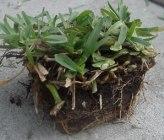
Plug (horticulture)
Encyclopedia

Horticulture
Horticulture is the industry and science of plant cultivation including the process of preparing soil for the planting of seeds, tubers, or cuttings. Horticulturists work and conduct research in the disciplines of plant propagation and cultivation, crop production, plant breeding and genetic...
are small-sized seedlings grown in trays
Trays
Traying or "doing trays" refers to a driving technique that is similar to drifting. Trays are performed when a fast-food tray is placed under the rear tires and then engaging the handbrake. After this is performed the driver goes forward turning the steering wheel so that the rear slip angle of the...
from expanded polystyrene or polythene filled usually with a peat
Peat
Peat is an accumulation of partially decayed vegetation matter or histosol. Peat forms in wetland bogs, moors, muskegs, pocosins, mires, and peat swamp forests. Peat is harvested as an important source of fuel in certain parts of the world...
substrate. This kind of plug is used for commercially raising vegetables and bedding plants. Similarly plugs may also refer to small sections of lawn
Lawn
A lawn is an area of aesthetic and recreational land planted with grasses or other durable plants, which usually are maintained at a low and consistent height. Low ornamental meadows in natural landscaping styles are a contemporary option of a lawn...
grass sod
Sod
Sod or turf is grass and the part of the soil beneath it held together by the roots, or a piece of thin material.The term sod may be used to mean turf grown and cut specifically for the establishment of lawns...
. When planted, the lawn grass will spread and take over adjacent areas.
Plug plants are young plants raised in small, individual cells, ready to be transplanted into containers or into the garden. The theory is that professionally raising vegetable/flowering plants in controlled conditions during the important formative period (the first 4–6 weeks) is the best way to ensure the plant can reach its maximum potential during the harvest/blooming period.
Why do gardeners use plug plants?
Planting from plugs reduces the time a crop resides in the ground - great for those with limited space.
Plugs can improve yields: a healthy, stocky plant will grow rapidly and symmetrically when planted out, with a potentially greater capacity to withstand pests, disease and drought.
Raising some types of seedlings successfully can be difficult, so plug plants are great for less experienced gardeners, also for gardeners who want to try a new variety or a range of varieties without purchasing tens of packets of seeds.
Plug plants are very useful if the sowing window is missed, or plugs can be purchased quickly to replace a crop which has failed.
As your garden develops, interplanting existing crops with plugs plants, ideally companion plants, will improve the productivity of the space and so maximise harvests- a sown crop may not be able to compete with established plants.
Plug plants are much easier to weed than sown seedlings, and weeding will need to be done less frequently.
Having semi-grown plants makes designing a vegetable plot or container really easy, and the results are instant!
Another good thing about plugs is the speed of growth. Within days of planting signs of growth are visible- leaves will perk up and roots anchor into the soil. Air pruned plugs are grown in a manner which means they begin very rapid growth the minute they hit new soil.
Plug plants grow more consistently, as has been noted by the commercial scale vegetable growing industry, and more rapidly; large scale brassica field crops are planted almost exclusively from soil block plugs in some parts of Europe, a trend which is growing in the UK. This success at the commercial scale is testament to the success of plugs in the ground.
It is of note that many varieties actively benefit from being transplanted as severing the taproot encourages bushier root growth. Traditionally nearly all heading brassica are sown in a separate seed bed, thinned, and the best ones planted in a prepared bed after about
6–8 weeks. Many pests want to eat baby brassica; this in combination with its long growing season makes planting brassica from plugs a much easier option.
In general, root vegetables must be sown from seed where they are to mature and then thinned. The thinning action is highly beneficial in itself as it provides soil aeration at depth without disturbing adjacent roots systems. The initial concentration of seedlings also
dilutes damage from pests and provided some food for the gardener or the compost in the form of thinnings. Beetroot, carrots and the root brassica family- swede, turnip- will simply not reach their full potential with any check to early root growth. In addition, these seeds are rarely expensive or the seedlings particularly delicate, hence there is little value to the gardener in buying or growing them as plugs.

